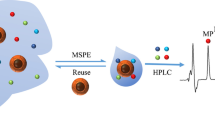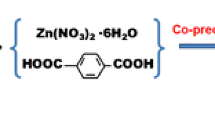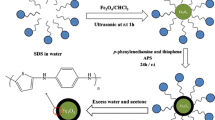Abstract
A novel covalent organic framework based magnetic adsorbent was developed for magnetic solid phase extraction (MSPE) of polycyclic aromatic hydrocarbons (PAHs). Covalent organic framework-LZU1 (= Lan Zhou University-1) was covalently immobilized onto polyethyleneimine-functionalized magnetic nanoparticles (COF-LZU1@PEI@Fe3O4), and the resulting material was characterized by transmission electron microscopy and Fourier transform infrared spectroscopy. The effects of the pH value of sample solution, percentage of acetonitrile, extraction time and sampling volume on MSPE of six PAHs were investigated. The COF-LZU1@PEI@Fe3O4 displays high extraction efficiency for the PAHs such as pyrene, benzo[a]pyrene, fluoranthene, benz[a]anthracene, benzo[a]fluorathene and dibenz[a,h]anthracene. Following desorption with acetonitrile, the PAHs were quantified by HPLC. The MSPE-HPLC method shows low limit of detection (0.2–20 pg mL−1), wide linear range and good reproducibility (relative standard deviations <4.4% for intra-day and inter-day precision). The method was successfully applied to determine PAHs in environmental samples. Good recoveries were obtained, ranging from 90.9 to 107.8% for water samples and 85.1 to 105.0% for soil samples.

Schematic of the preparation of magnetic nanoparticles modified with a covalent organic framework (COF-LZU1) for extraction of polycyclic aromatic hydrocarbons prior to quantitation by HPLC. PEI: Polyethyleneimine.





Similar content being viewed by others
References
Cote AP, Benin AI, Ockwig NW, O'Keeffe M, Matzger AJ, Yaghi OM (2005) Porous, crystalline, covalent organic frameworks. Science 310(5751):1166–1170
Feng X, Ding X, Jiang D (2012) Covalent organic frameworks. Chem Soc Rev 41(18):6010–6022
El-Kaderi HM, Hunt JR, Mendoza-Cortés JL, Côté AP, Taylor RE, O'Keeffe M, Yaghi OM (2007) Designed synthesis of 3D covalent organic frameworks. Science 316(5822):268–272
Ding S-Y, Wang W (2013) Covalent organic frameworks (COFs): from design to applications. Chem Soc Rev 42(2):548–568
Cote AP, El-Kaderi HM, Furukawa H, Hunt JR, Yaghi OM (2007) Reticular synthesis of microporous and mesoporous 2D covalent organic frameworks. J Am Chem Soc 129(43):12914–12915
Dalapati S, Jin S, Gao J, Xu Y, Nagai A, Jiang D (2013) An azine-linked covalent organic framework. J Am Chem Soc 135(46):17310–17313
Liu Y, Ma Y, Zhao Y, Sun X, Gándara F, Furukawa H, Liu Z, Zhu H, Zhu C, Suenaga K (2016) Weaving of organic threads into a crystalline covalent organic framework. Science 351(6271):365–369
Han SS, Furukawa H, Yaghi OM, Goddard Iii WA (2008) Covalent organic frameworks as exceptional hydrogen storage materials. J Am Chem Soc 130(35):11580–11581
Furukawa H, Yaghi OM (2009) Storage of hydrogen, methane, and carbon dioxide in highly porous covalent organic frameworks for clean energy applications. J Am Chem Soc 131(25):8875–8883
Rabbani MG, Sekizkardes AK, Kahveci Z, Reich TE, Ding R, El-Kaderi HM (2013) A 2D Mesoporous Imine-Linked Covalent Organic Framework for High Pressure Gas Storage Applications. Chem-Eur J 19(10):3324–3328
Keskin S (2012) Adsorption, diffusion, and separation of CH4/H2 mixtures in covalent organic frameworks: molecular simulations and theoretical predictions. J Phys Chem C 116(2):1772–1779
Huang N, Chen X, Krishna R, Jiang D (2015) Two-Dimensional Covalent Organic Frameworks for Carbon Dioxide Capture through Channel-Wall Functionalization. Angew Chem Int Ed 54(10):2986–2990
Wan S, Guo J, Kim J, Ihee H, Jiang D (2009) A Photoconductive Covalent Organic Framework: Self-Condensed Arene Cubes Composed of Eclipsed 2D Polypyrene Sheets for Photocurrent Generation. Angew Chem Int Ed 121(30):5547–5550
Chen L, Furukawa K, Gao J, Nagai A, Nakamura T, Dong Y, Jiang D (2014) Photoelectric covalent organic frameworks: converting open lattices into ordered donor–acceptor heterojunctions. J Am Chem Soc 136(28):9806–9809
Ding S-Y, Gao J, Wang Q, Zhang Y, Song W-G, Su C-Y, Wang W (2011) Construction of covalent organic framework for catalysis: Pd/COF-LZU1 in Suzuki–Miyaura coupling reaction. J Am Chem Soc 133(49):19816–19822
Fang Q, Gu S, Zheng J, Zhuang Z, Qiu S, Yan Y (2014) 3D Microporous Base-Functionalized Covalent Organic Frameworks for Size-Selective Catalysis. Angew Chem Int Ed 53(11):2878–2882
Yang C-X, Liu C, Cao Y-M, Yan X-P (2015) Facile room-temperature solution-phase synthesis of a spherical covalent organic framework for high-resolution chromatographic separation. Chem Commun 51(61):12254–12257
Bao T, Tang P, Kong D, Mao Z, Chen Z (2016) Polydopamine-supported immobilization of covalent-organic framework-5 in capillary as stationary phase for electrochromatographic separation. J Chromatogr A 1445:140–148
Niu X, Ding S, Wang W, Xu Y, Xu Y, Chen H, Chen X (2016) Separation of small organic molecules using covalent organic frameworks-LZU1 as stationary phase by open-tubular capillary electrochromatography. J Chromatogr A 1436:109–117
Zhang Z, Huang Y, Ding W, Li G (2014) Multilayer interparticle linking hybrid MOF-199 for noninvasive enrichment and analysis of plant hormone ethylene. Anal Chem 86(7):3533–3540
Xie L, Liu S, Han Z, Jiang R, Liu H, Zhu F, Zeng F, Su C, Ouyang G (2015) Preparation and characterization of metal-organic framework MIL-101 (Cr)-coated solid-phase microextraction fiber. Anal Chim Acta 853:303–310
Chang N, Gu Z-Y, Wang H-F, Yan X-P (2011) Metal–organic-framework-based tandem molecular sieves as a dual platform for selective microextraction and high-resolution gas chromatographic separation of n-alkanes in complex matrixes. Anal Chem 83(18):7094–7101
Zhang J, Zhang W, Bao T, Chen Z (2015) Polydopamine-based immobilization of zeolitic imidazolate framework-8 for in-tube solid-phase microextraction. J Chromatogr A 1388:9–16
Xu L, Qi X, Li X, Bai Y, Liu H (2016) Recent advances in applications of nanomaterials for sample preparation. Talanta 146:714–726
Wu M, Chen G, Liu P, Zhou W, Jia Q (2016) Polydopamine-based immobilization of a hydrazone covalent organic framework for headspace solid-phase microextraction of pyrethroids in vegetables and fruits. J Chromatogr A 1456:34–41
Wu M, Chen G, Ma J, Liu P, Jia Q (2016) Fabrication of cross-linked hydrazone covalent organic frameworks by click chemistry and application to solid phase microextraction. Talanta 161:350–358
Spietelun A, Marcinkowski Ł, de la Guardia M, Namieśnik J (2013) Recent developments and future trends in solid phase microextraction techniques towards green analytical chemistry. J Chromatogr A 1321:1–13
Mehdinia A, Aziz-Zanjani MO (2013) Advances for sensitive, rapid and selective extraction in different configurations of solid-phase microextraction. Trends Anal Chem 51:13–22
Wierucka M, Biziuk M (2014) Application of magnetic nanoparticles for magnetic solid-phase extraction in preparing biological, environmental and food samples. Trends Anal Chem 59:50–58
Goon IY, Lai LM, Lim M, Munroe P, Gooding JJ, Amal R (2009) Fabrication and dispersion of gold-shell-protected magnetite nanoparticles: systematic control using polyethyleneimine. Chem Mater 21(4):673–681
Bunkoed O, Kanatharana P (2015) Extraction of polycyclic aromatic hydrocarbons with a magnetic sorbent composed of alginate, magnetite nanoparticles and multiwalled carbon nanotubes. Microchim Acta 182:1519–1526
Mehdinia A, Khojasteh E, Kayyal TB, Jabbari A (2014) Magnetic solid phase extraction using gold immobilized magnetic mesoporous silica nanoparticles coupled with dispersive liquid–liquid microextraction for determination of polycyclic aromatic hydrocarbons. J Chromatogr A 1364:20–27
Zhang W, Zhang J, Bao T, Zhou W, Meng J, Chen Z (2013) Universal multilayer assemblies of graphene in chemically resistant microtubes for microextraction. Anal Chem 85(14):6846–6854
Amiri A, Baghayeri M, Kashmari M (2016) Magnetic nanoparticles modified with polyfuran for the extraction of polycyclic aromatic hydrocarbons prior to their determination by gas chromatography. Microchim Acta 183(1):149–156
Xue S-W, Tang M-Q, Xu L, Z-g S (2015) Magnetic nanoparticles with hydrophobicity and hydrophilicity for solid-phase extraction of polycyclic aromatic hydrocarbons from environmental water samples. J Chromatogr A 1411:9–16
Wang M, Cui S, Yang X, Bi W (2015) Synthesis of gC3N4/Fe3O4 nanocomposites and application as a new sorbent for solid phase extraction of polycyclic aromatic hydrocarbons in water samples. Talanta 132:922–928
Shi Y, Wu H, Wang C, Guo X, Du J, Du L (2016) Determination of polycyclic aromatic hydrocarbons in coffee and tea samples by magnetic solid-phase extraction coupled with HPLC–FLD. Food Chem 199:75–80
Zhang S, Yao W, Ying J, Zhao H (2016) Polydopamine-reinforced magnetization of zeolitic imidazolate framework ZIF-7 for magnetic solid-phase extraction of polycyclic aromatic hydrocarbons from the air-water environment. J Chromatogr A 1452:18–26
Acknowledgements
This work was supported by the National Natural Science Foundation of China (Grant No.81573384, 21375101 and 91417301), and Natural Science Foundation of Hubei Province (No. 2014CFA077).
Author information
Authors and Affiliations
Corresponding author
Ethics declarations
The author(s) declare that they have no competing interests.
Electronic supplementary material
ESM 1
(DOCX 1243 kb)
Rights and permissions
About this article
Cite this article
Wang, R., Chen, Z. A covalent organic framework-based magnetic sorbent for solid phase extraction of polycyclic aromatic hydrocarbons, and its hyphenation to HPLC for quantitation. Microchim Acta 184, 3867–3874 (2017). https://doi.org/10.1007/s00604-017-2408-8
Received:
Accepted:
Published:
Issue Date:
DOI: https://doi.org/10.1007/s00604-017-2408-8




